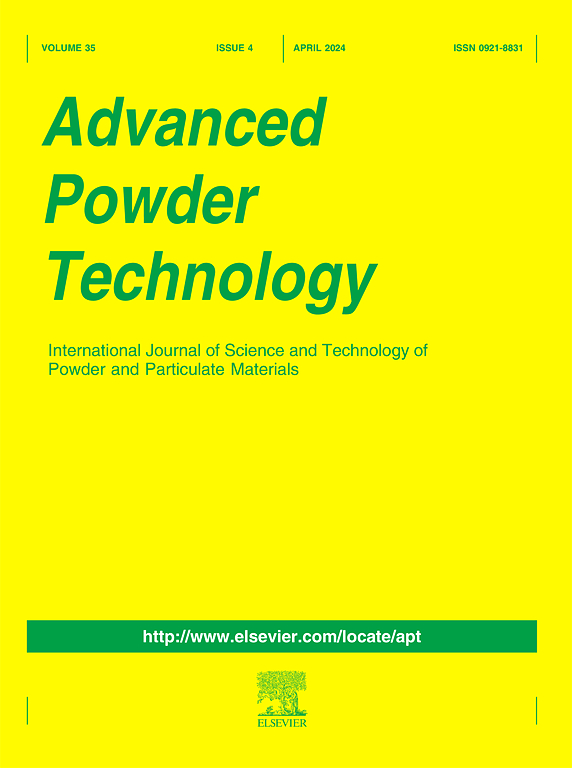探讨了十二磷酸/多胺正阴离子缔合捕收剂对白钨矿的捕收能力
IF 4.2
2区 工程技术
Q2 ENGINEERING, CHEMICAL
引用次数: 0
摘要
白钨矿的高效浮选对钨资源的安全生产至关重要。将十二烷基磷酸钾(MAP-K)与二乙基三胺(DETA)、三乙基四胺(TETA)和四乙基四胺(TEPA)混合,设计了一种全新的阳离子-阴离子结合捕收剂。通过微浮选、zeta电位、接触角和吸附量检测,系统研究了阳离子-阴离子缔合捕收剂对白钨矿的捕收性能。微浮选结果表明,正阴离子结合捕收剂TTK (MAP-K与TETA的M比为2:1)对白钨矿具有良好的捕收能力,在5.0×10−4 mol/L TTK浓度下回收率可达97.53%,而MAP-K浓度下回收率仅为70.37%。结果表明,TTK处理后白钨矿的zeta电位发生了正位移,表明TTK在正阴离子结合过程中发生了氨基质子化。带正电的TTK可能对白钨矿具有静电吸引力,有利于TTK中的磷酸基团在白钨矿表面吸附。TTK的吸附能(−11.082 eV)是MAP−(−5.072 eV)的近两倍。因此,DETA促进了MAP-K在白钨矿上的吸附,增强了白钨矿的疏水性。本文章由计算机程序翻译,如有差异,请以英文原文为准。

Probing the improved collecting ability of dodecyl phosphate/poly-amine cation-anion association collector towards scheelite
Efficient flotation of scheelite is very important for the safety of tungsten resources. A brand new collector, i.e., cation–anion association, was designed by mixing potassium dodecyl phosphate (MAP-K) with amines including diethylenetriamine (DETA), triethylene tetramine (TETA) and tetraethylenepentamine (TEPA). The collecting performance of these cation–anion association collectors toward scheelite were systematically studied through micro-flotation, zeta potential, contact angle and adsorption capacity detection. The micro-flotation results implied that cation–anion association collector TTK (MAP-K and TETA at 2:1 M ratio) performed excellent collecting ability toward scheelite, and the recovery reached to 97.53% under concentration of 5.0×10−4 mol/L TTK, while that was only 70.37% with MAP-K. It was found that the zeta potential of TTK-treated scheelite was positive shifted, implying that the amino group was protonated in cation–anion association of TTK. The positively charged TTK may have an electrostatic attraction of scheelite, facilitating the adsorption of phosphate groups in TTK on scheelite surface. The adsorption energy of the TTK (−11.082 eV) was nearly the twice that of MAP− (−5.072 eV). Therefore, DETA facilitated the adsorption of MAP-K on scheelite and strengthened the hydrophobicity of scheelite.
求助全文
通过发布文献求助,成功后即可免费获取论文全文。
去求助
来源期刊

Advanced Powder Technology
工程技术-工程:化工
CiteScore
9.50
自引率
7.70%
发文量
424
审稿时长
55 days
期刊介绍:
The aim of Advanced Powder Technology is to meet the demand for an international journal that integrates all aspects of science and technology research on powder and particulate materials. The journal fulfills this purpose by publishing original research papers, rapid communications, reviews, and translated articles by prominent researchers worldwide.
The editorial work of Advanced Powder Technology, which was founded as the International Journal of the Society of Powder Technology, Japan, is now shared by distinguished board members, who operate in a unique framework designed to respond to the increasing global demand for articles on not only powder and particles, but also on various materials produced from them.
Advanced Powder Technology covers various areas, but a discussion of powder and particles is required in articles. Topics include: Production of powder and particulate materials in gases and liquids(nanoparticles, fine ceramics, pharmaceuticals, novel functional materials, etc.); Aerosol and colloidal processing; Powder and particle characterization; Dynamics and phenomena; Calculation and simulation (CFD, DEM, Monte Carlo method, population balance, etc.); Measurement and control of powder processes; Particle modification; Comminution; Powder handling and operations (storage, transport, granulation, separation, fluidization, etc.)
 求助内容:
求助内容: 应助结果提醒方式:
应助结果提醒方式:


